It's time to make merry with a few of our favorite selections.
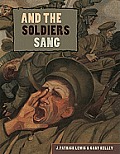 And the Soldiers Sang by J. Patrick Lewis, illustrated by Gary Kelley (Creative Editions, $17.99 hardcover, 9781568462202, 32p., ages 9-12, August 2011)
And the Soldiers Sang by J. Patrick Lewis, illustrated by Gary Kelley (Creative Editions, $17.99 hardcover, 9781568462202, 32p., ages 9-12, August 2011)
This emotionally haunting story of the Christmas truce held in 1914 across enemy lines is a powerful reminder that many soldiers will not be celebrating Christmas this year. Poet J. Patrick Lewis adopts a prose style that pulls no punches: "Over the humps of the dead and wounded, he spotted small, candlelit pines ghosting the German line." Gary Kelley's (Eleanor, Quiet No More) panel and full-page illustrations in dark, somber tones similarly do not shy away from images of the fallen. But when the two sides come together, the mood feels almost hopeful as a result. The faces of the soldiers singing Christmas carols seem to be lit from within. Although the book ends on a realistically tragic note, it also provides a strong example of the hopelessness of war, even as its soldiers hold out hope.
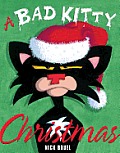 A Bad Kitty Christmas by Nick Bruel (Neal Porter/Roaring Brook, $15.99 hardcover, 9781596436688, 40p., ages 4-up, September 2011)
A Bad Kitty Christmas by Nick Bruel (Neal Porter/Roaring Brook, $15.99 hardcover, 9781596436688, 40p., ages 4-up, September 2011)
With a tip of the hat to Clement C. Moore, Nick Bruel depicts Bad Kitty in full mischievous force Christmas morning, as her owner ticks off her misdeeds, A to Z. "The eggnog was ended./ The fruitcake was flung./ The gifts were all gutted./ The holly un-hung." Each warrants one of Bruel's trademark cartoon panels with the highlighted letter capitalized in festive red. But when Bad Kitty escapes the family car en route to Uncle Murray's, she is taken in by a lonely, elderly woman, and the feline finds a way to return her good deed. Like Scrooge, even Bad Kitty can redeem herself on Christmas--but not before plenty of comical antics.
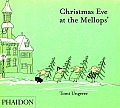 Christmas Eve at the Mellops by Tomi Ungerer (Phaidon, $12.95 hardcover, 9780714862507, 32p., ages 3-7, October 2011)
Christmas Eve at the Mellops by Tomi Ungerer (Phaidon, $12.95 hardcover, 9780714862507, 32p., ages 3-7, October 2011)
Here's a holiday classic from Tomi Ungerer (Crictor), first published in 1960 and newly reissued, that we couldn't resist. When Mr. Mellops enthusiastically shares with his four boys an article about Christmas tree decorations, each in turn decides to "surprise his father" and chop down a tree. "What a to-do when they got them home! The Mellops' hall was filled with trees and tears." That is, until Santa suggests they give away their trees to those in need. In tones of peach and melon green within a fine black outline, Ungerer gently delivers a message of making gifts count. The boys' mission to deliver their trees leads to more good deeds, and a feeling of teamwork pervades the tale. One word of caution: if you still have believers in the house, they may be confused by Mr. Mellops dressed as Santa. Other Mellops books back at last: The Mellops Go Diving for Treasure (9780714862484); The Mellops Strike Oil (9780714862491).
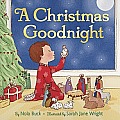 A Christmas Goodnight by Nola Buck, illustrated by Sarah Jane Wright (Katherine Tegen/HarperCollins, $12.99 hardcover, 9780061664915, 24p., ages 2-5, October 2011)
A Christmas Goodnight by Nola Buck, illustrated by Sarah Jane Wright (Katherine Tegen/HarperCollins, $12.99 hardcover, 9780061664915, 24p., ages 2-5, October 2011)
Nola Buck's (Christmas in the Manger) bedtime book begins with "Goodnight to the baby in the hay," the one at the center of the Christmas holiday, dressed in swaddling clothes and surrounded by animals in the manger. She then shifts to a different climate with "frosty air," falling snow and a "leaping hare," and brings the story home to a modern child on Christmas Eve. Sarah Jane Wright, in a remarkable debut, seamlessly connects the two children at the center of Buck's narrative by focusing on the Holy family at close range, then depicting the departure of the Wise Men in an aerial view ("Goodnight to their camels tall./ Goodnight to the shepherds and their sheep./ Goodnight, goodnight to them all!"). A turn of the page shows the snowy landscape with a warm light from a window that turns out to be the modern child's bedroom where he's laid out his miniature Nativity set (it bears a striking resemblance to the book's opening scene). Buck and Wright create both a soothing and expectant tone just right for nighttime reading during Advent.
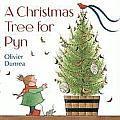 A Christmas Tree for Pyn by Olivier Dunrea (Philomel/Penguin, $16.99, 9780399245060, 32p., ages 3-8, October 2011)
A Christmas Tree for Pyn by Olivier Dunrea (Philomel/Penguin, $16.99, 9780399245060, 32p., ages 3-8, October 2011)
Olivier Dunrea's (Gossie) book quietly builds to an emotional climax that may well take you by surprise. Young Pyn lives with her "bearlike mountain man" father who barely says a word, though he "loved his daughter very much." When she calls him Papa, he says, "My name is Oother." Pyn makes her father's bed and his dinner, and though he barely responds ("Umphf") Dunrea also suggests a smile in the corner of the man's eyes. When Pyn has her heart set on a tree, the man gives in, and we begin to see why he'd been so resistant. Dunrea's strong horizontal lines and geometric shapes in the interiors reinforce the modest living quarters yet also keep a cozy feeling. Once father and daughter venture outside, the spreads become airy, with sloping hills and pine trees you can almost touch. A mastery of understatement.
 Duke Ellington's Nutcracker Suite by Anna Harwell Celenza, illustrated by Don Tate (Charlesbridge, $19.95 hardcover with CD, 9781570917004, 32p., ages 6-9, November 2011)
Duke Ellington's Nutcracker Suite by Anna Harwell Celenza, illustrated by Don Tate (Charlesbridge, $19.95 hardcover with CD, 9781570917004, 32p., ages 6-9, November 2011)
Anna Harwell Celenza, a musicologist, gives young readers the background to the jazz great's take on the holiday ballet classic by Tchaikovsky. She describes the year 1960 when Duke Ellington's band was all the rage in Las Vegas, and Billy Strayhorn, was his co-composer. A record producer's invitation inspires Ellington and Strayhorn to interpret Tchaikovsky with a jazz beat. In Strayhorn's words, "You couldn't ask for better dance music." Don Tate's (Black All Around) stylized illustrations depict Strayhorn's sugar plum visions (literally), which seem to float on air, while the band musicians swing to the beat. Best of all, a CD of their recording is tucked into the back cover so youngsters can hear what Celenza describes as Aaron's "deep, bluesy bass line" on the overture, and the entrance of the toy pipes on "Toot Toot Tootie Toot" (otherwise known as "Dance of the Reed Pipes").
 The Flying Canoe: A Christmas Story by Eric A. Kimmel, illustrated by Daniel San Souci and Justin San Souci (Holiday House, $16.95, 9780823417308, 32p., ages 4-8, August 2011)
The Flying Canoe: A Christmas Story by Eric A. Kimmel, illustrated by Daniel San Souci and Justin San Souci (Holiday House, $16.95, 9780823417308, 32p., ages 4-8, August 2011)
What would you promise in order to be home with your family on Christmas Eve? Six French fur traders vow to a stranger that they will not speak a word until they reach their homes in Montreal, if he will follow through on his claim that he can get them there by Christmas in their canoe. Old Armand has his doubts, but he is outnumbered, so he goes along with the bargain. Kimmel, a skilled reteller of folktales, gets the pacing just right, with a narrative ideal for reading aloud. The father-and-son artist team (with son Justin making his debut) creates predominately dark, mysterious compositions with the characters lit by candlelight; their elongated faces resemble magical elfin creatures.
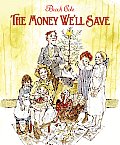 The Money We'll Save by Brock Cole (Margaret Ferguson/Farrar, Straus & Giroux, $16.99 hardcover, 9780374350116, 40p., ages 4-up, October 11, 2011)
The Money We'll Save by Brock Cole (Margaret Ferguson/Farrar, Straus & Giroux, $16.99 hardcover, 9780374350116, 40p., ages 4-up, October 11, 2011)
Brock Cole's (Good Enough to Eat) comical take on holiday preparations conveys a moral that family matters most. With all the children involved in chores, Ma sends Pa to buy two eggs and a half pound of flour. "Remember, Christmas is not far off, and we must save every penny," she warns him. "I'll remember," he says. And he does. At first. But the chicken man is a wheeler dealer who talks Pa into buying a turkey poult that will "fatten up into a fine bird" for Christmas dinner. The children name him Alfred, and the bird eats everything in sight. Though the family must scrimp and save, Cole's loose line and ruddy-cheeked characters keep the tone light, and the love among the family members in the foreground. The twist ending cleverly conveys a true message of giving and forgiveness.
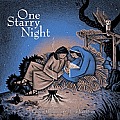 One Starry Night by Lauren Thompson, illustrated by Jonathan Bean (McElderry/S&S, $16.99 hardcover, 9780689828515, 32p., ages 2-6, October 4, 2011)
One Starry Night by Lauren Thompson, illustrated by Jonathan Bean (McElderry/S&S, $16.99 hardcover, 9780689828515, 32p., ages 2-6, October 4, 2011)
Lauren Thompson's (Polar Bear Night) lilting text coupled with Jonathan Bean's (At Night) soothing illustrations in midnight blues and sand-colored tones works on two levels that combine to create the feeling of a lullaby for youngest readers. As "a sheep watche[s] over her lamb" and "a cow watche[s] over her calf," another thread (in italics) may be read alongside the animals' narrative or independently ("I am here/ always near..."). Bean uses pencil, and colors his drawings digitally, yet the texture evokes pastels, and the dramatic landscape of jagged rock formations and desert plains seem to glow in the moonlight. Thompson's rhythmic refrain concludes with "Mary and Joseph watch[ing] over their newborn babe," as all of the animals mentioned begin to gather 'round them. The poetic secondary narrative becomes a prayer ("God's will be done") that young readers will feel is directed just as much to them ("beloved one") as it is to the Christ child.
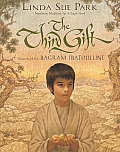 The Third Gift by Linda Sue Park, illustrated by Bagram Ibatoulline (Clarion/Houghton Mifflin Harcourt, $16.99 hardcover, 9780547201955, 32p., ages 6-9, November 15, 2011)
The Third Gift by Linda Sue Park, illustrated by Bagram Ibatoulline (Clarion/Houghton Mifflin Harcourt, $16.99 hardcover, 9780547201955, 32p., ages 6-9, November 15, 2011)
Linda Sue Park (A Single Shard) takes a fresh and moving approach to the story of the magi by telling it from the viewpoint of a child whose father harvests the myrrh that will serve as one of their three gifts. Everything about Park's narrative ties into the larger Christ story without ever mentioning Jesus' name. The boy's father teaches him how to harvest the "tears," the name for the pearls of sap from the tree that bring forth the myrrh. Myrrh may be used as a medicine and to flavor wine, but the most expensive tears are burned at funerals, with a scent "both bitter and sweet." The properties of myrrh evoke Christ's miracle of healing, the communion and his bittersweet mission. Bagram Ibatoulline's textured earth-toned landscapes stand in stark contrast to the abundance of the spice trader's tent and the regal dress of the magi. Author and artist's juxtaposition of the practical and the mysterious gets to the heart of the holiday's complexity in a way that children can tap into and grasp more of each time they read it. --Jennifer M. Brown
 September bookstore sales jumped 7%, to $1.55 billion, compared to September 2010, according to preliminary estimates from the Census Bureau. For the year to date, bookstore sales have risen 2.8%, to $12.024 billion.
September bookstore sales jumped 7%, to $1.55 billion, compared to September 2010, according to preliminary estimates from the Census Bureau. For the year to date, bookstore sales have risen 2.8%, to $12.024 billion.


SHELFAWARENESS.1222.S1.BESTADSWEBINAR.gif)


SHELFAWARENESS.1222.T1.BESTADSWEBINAR.gif)
 In a post headlined "
In a post headlined " Congratulations to
Congratulations to 
 The new commercials for Barnes & Noble's Nook Tablet feature thriller author
The new commercials for Barnes & Noble's Nook Tablet feature thriller author  Penguin Group has launched a
Penguin Group has launched a  On Sunday, Cameron + Company held a launch party for Kiki & Coco in Paris at Maude, a children's boutique in Petaluma, Calif. French music played, a slideshow of photos from the book were projected on the walls and little girls (and a few boys) sat at a craft table and designed dresses with fabric and paper dolls. Celebrating (in the middle, from l.): Jess Brown, owner of Maude and doll maker who makes Coco dolls from the book; photographer Stephanie Rausser; and author Nina Gruener; (in back) Cameron head Chris Gruener; and in front, Kiki, Rausser's daughter, star of the book and three to four years older than she was in the book.
On Sunday, Cameron + Company held a launch party for Kiki & Coco in Paris at Maude, a children's boutique in Petaluma, Calif. French music played, a slideshow of photos from the book were projected on the walls and little girls (and a few boys) sat at a craft table and designed dresses with fabric and paper dolls. Celebrating (in the middle, from l.): Jess Brown, owner of Maude and doll maker who makes Coco dolls from the book; photographer Stephanie Rausser; and author Nina Gruener; (in back) Cameron head Chris Gruener; and in front, Kiki, Rausser's daughter, star of the book and three to four years older than she was in the book.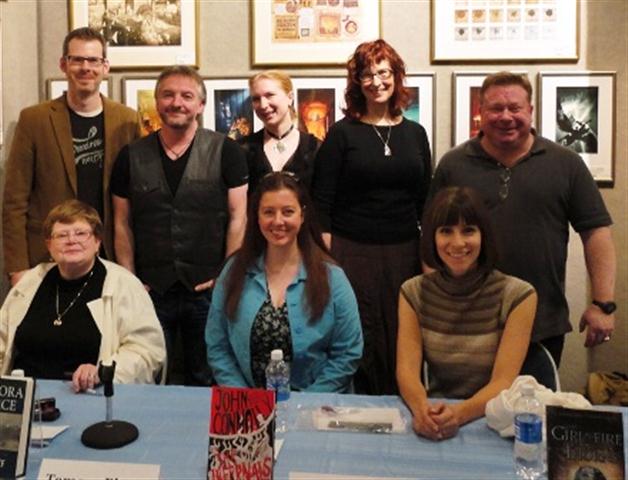
 Salman Rushdie made the mighty Facebook back down in a confrontation over his name. The author objected vehemently when Facebook "
Salman Rushdie made the mighty Facebook back down in a confrontation over his name. The author objected vehemently when Facebook " After receiving B.A. degrees in psychology and English literature from Lake Forest College,
After receiving B.A. degrees in psychology and English literature from Lake Forest College, 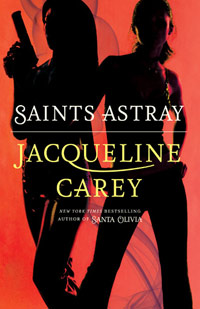 Book you've faked reading:
Book you've faked reading: And the Soldiers Sang by J. Patrick Lewis, illustrated by Gary Kelley (Creative Editions, $17.99 hardcover, 9781568462202, 32p., ages 9-12, August 2011)
And the Soldiers Sang by J. Patrick Lewis, illustrated by Gary Kelley (Creative Editions, $17.99 hardcover, 9781568462202, 32p., ages 9-12, August 2011) A Bad Kitty Christmas by Nick Bruel (Neal Porter/Roaring Brook, $15.99 hardcover, 9781596436688, 40p., ages 4-up, September 2011)
A Bad Kitty Christmas by Nick Bruel (Neal Porter/Roaring Brook, $15.99 hardcover, 9781596436688, 40p., ages 4-up, September 2011) Christmas Eve at the Mellops by Tomi Ungerer (Phaidon, $12.95 hardcover, 9780714862507, 32p., ages 3-7, October 2011)
Christmas Eve at the Mellops by Tomi Ungerer (Phaidon, $12.95 hardcover, 9780714862507, 32p., ages 3-7, October 2011) A Christmas Goodnight by Nola Buck, illustrated by Sarah Jane Wright (Katherine Tegen/HarperCollins, $12.99 hardcover, 9780061664915, 24p., ages 2-5, October 2011)
A Christmas Goodnight by Nola Buck, illustrated by Sarah Jane Wright (Katherine Tegen/HarperCollins, $12.99 hardcover, 9780061664915, 24p., ages 2-5, October 2011) A Christmas Tree for Pyn by Olivier Dunrea (Philomel/Penguin, $16.99, 9780399245060, 32p., ages 3-8, October 2011)
A Christmas Tree for Pyn by Olivier Dunrea (Philomel/Penguin, $16.99, 9780399245060, 32p., ages 3-8, October 2011) Duke Ellington's Nutcracker Suite by Anna Harwell Celenza, illustrated by Don Tate (Charlesbridge, $19.95 hardcover with CD, 9781570917004, 32p., ages 6-9, November 2011)
Duke Ellington's Nutcracker Suite by Anna Harwell Celenza, illustrated by Don Tate (Charlesbridge, $19.95 hardcover with CD, 9781570917004, 32p., ages 6-9, November 2011) The Flying Canoe: A Christmas Story by Eric A. Kimmel, illustrated by Daniel San Souci and Justin San Souci (Holiday House, $16.95, 9780823417308, 32p., ages 4-8, August 2011)
The Flying Canoe: A Christmas Story by Eric A. Kimmel, illustrated by Daniel San Souci and Justin San Souci (Holiday House, $16.95, 9780823417308, 32p., ages 4-8, August 2011) The Money We'll Save by Brock Cole (Margaret Ferguson/Farrar, Straus & Giroux, $16.99 hardcover, 9780374350116, 40p., ages 4-up, October 11, 2011)
The Money We'll Save by Brock Cole (Margaret Ferguson/Farrar, Straus & Giroux, $16.99 hardcover, 9780374350116, 40p., ages 4-up, October 11, 2011) One Starry Night by Lauren Thompson, illustrated by Jonathan Bean (McElderry/S&S, $16.99 hardcover, 9780689828515, 32p., ages 2-6, October 4, 2011)
One Starry Night by Lauren Thompson, illustrated by Jonathan Bean (McElderry/S&S, $16.99 hardcover, 9780689828515, 32p., ages 2-6, October 4, 2011) The Third Gift by Linda Sue Park, illustrated by Bagram Ibatoulline (Clarion/Houghton Mifflin Harcourt, $16.99 hardcover, 9780547201955, 32p., ages 6-9, November 15, 2011)
The Third Gift by Linda Sue Park, illustrated by Bagram Ibatoulline (Clarion/Houghton Mifflin Harcourt, $16.99 hardcover, 9780547201955, 32p., ages 6-9, November 15, 2011)